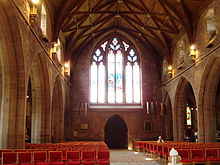|
St Asaph Cathedral
  The Cathedral Church of Saints Asaph and Cyndeyrn, commonly called St Asaph Cathedral (Welsh: Eglwys Gadeiriol Llanelwy), is a cathedral in St Asaph, Denbighshire, north Wales. It is the episcopal seat of the Bishop of St Asaph. The cathedral dates back 1,400 years, while the current building dates from the 13th century.[1] The cathedral is part of the Church in Wales and part of the Anglican Communion of Wales. HistoryA church was originally built on or near the site by Saint Kentigern in the 6th century (other sources say Saint Elwy in 560). Saint Asa (or Asaph), a grandson of Pabo Post Prydain, followed after this date. The earliest parts of the present building date from the 13th century when a new building was begun on the site after the original stone cathedral was burnt by soldiers of King Edward I during the Second Welsh War in 1282. Indeed, there had been plans, following the First Welsh War (1277) to relocate the church to Rhuddlan, plans supported by Bishop Anian (Einion I). However these plans came to nought following the war of 1282, as Conwy and Caernarfon were considered to be the new centres of administration.[2] The rebellion of Owain Glyndŵr resulted in part of the cathedral being reduced to a ruin for seventy years. The present building was largely built in the reign of Henry Tudor and greatly restored in the 19th century. The cathedral made the national press in 1930 when the tower became subject to significant subsidence and the cathedral architect Charles Marriott Oldrid Scott advised of urgent repairs to be undertaken.[3][4] It was reported that the cause of the damage was by a subterranean stream.[5] It made the papers again when work was approaching completion in 1935.[6] Geoffrey of Monmouth served as Bishop of St Asaph from 1152 to 1155, although due to war and unrest in Wales at the time, he probably never set foot in his see. William Morgan (1545 – 10 September 1604) was also Bishop of St Asaph and of Llandaff, and was the first to translate the whole Bible, from Greek and Hebrew, into Welsh. His Bible is kept on public display in the cathedral. The first Archbishop of Wales A. G. Edwards was appointed Bishop of St Asaph in 1889. In August 2018, the cathedral took the controversial step of making its music staff redundant, citing financial pressures.[7] The cathedral have since reestablished the position of Director of music following the appointment of Paul Booth from September 2019. The choir continue to sing for three services a week. The organA specification of the organ can be found on the National Pipe Organ Register.[8] List of organists
Assistant organists
Assistant Director of Music
Burials
See also
References
Further readingExternal links
|
||||||||||||||||||||||||||||||||||||||||||||||||||||||||||||||||||||||||||||||||||||||||||||||||

